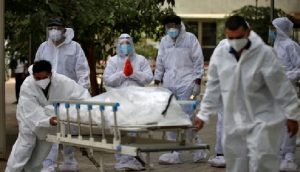21-07-2024
Bureau Report + Agencies
NEW DELHI: India’s actual death toll during the first phase of the COVID-19 pandemic that ravaged the world’s most populous country could be eight times higher than the government’s official numbers, reveals a new study while that initial wave of the virus caught the world off guard, leaving governments and health systems scrambling for responses, India, after implementing a strict lockdown, appeared to have escaped the worst of its effects. The country was devastated by the delta variant in 2021 when hospitals ran out of beds and oxygen, people died gasping outside healthcare facilities and rows upon rows of smoldering pyres chequered cremation grounds across the country but the new research suggests that the first wave, while not as deadly as the one in 2021, wrought far greater devastation than has been acknowledged until now.
 The study, co-authored by 10 demographers and economists from elite international institutes, found that India had 1.19 million excess deaths in 2020, during the pandemic’s first wave, compared to 2019.
The study, co-authored by 10 demographers and economists from elite international institutes, found that India had 1.19 million excess deaths in 2020, during the pandemic’s first wave, compared to 2019.
That’s eight times India’s official COVID-19 toll for 2020, of 148,738 deaths. The study was published Friday in the Science Advances publication.
The numbers in the research, based on the Indian government’s 2019-21 National Family Health Survey (NFHS), a comprehensive report on the state of the country’s health and family welfare, are also 1.5 times the World Health Organization’s (WHO) estimate for India’s COVID-19 death toll in 2020.
India’s own total count of deaths from the virus until the end of 2021 stands at 481,000 but the new research also uncovers deep inequalities among the pandemic’s victims based on gender, caste and religion.
The research found that in 2020, the life expectancy of an upper-caste Indian of the Hindu faith went down by 1.3 years. By contrast, the average lifespan for people from ‘scheduled castes’ communities that for centuries faced the worst discrimination under the caste system went down by 2.7 years.
Indian Muslims suffered the worst, their life expectancy went down by 5.4 years in 2020.
These communities had lower life expectancy at birth relative to high-caste Hindus even before the pandemic, the study noted. “The pandemic exacerbated these disparities,” it added. “These declines are comparable or larger in absolute magnitude to those experienced by Native Americans, Blacks, and Hispanics in the United States in 2020.”
 “Muslims have been facing marginalization for a long time, and it has been intensified in the last few years,” said Aashish Gupta, one of the authors of the study and a Marie Sklodowska-Curie Fellow at the University of Oxford.
“Muslims have been facing marginalization for a long time, and it has been intensified in the last few years,” said Aashish Gupta, one of the authors of the study and a Marie Sklodowska-Curie Fellow at the University of Oxford.
“We do not have any data to suggest that one group or community had more infection than others,” Gupta told media. “However, when Muslims did get COVID, findings show that they were really shunned, faced stereotypes and lacked access to healthcare. The marginalized communities were left to their devices.”
T Sundararaman, a public health expert who has served as executive director of the National Health Systems Resource Centre, the Indian Ministry of Health’s think tank, said that this trend is “consistent with what we know about how the disease affects mortality rates”.
“The consequences are more pronounced upon more marginalized sections … everything adds on,” he said. The study found that women also suffered more than men while the life expectancy among Indian men fell in 2020 by 2.1 years, it fell an extra year for women. This contrasts with the global trend overall, across the world, the life expectancy of men fell more during the pandemic.
 Pressmediaofindia
Pressmediaofindia




